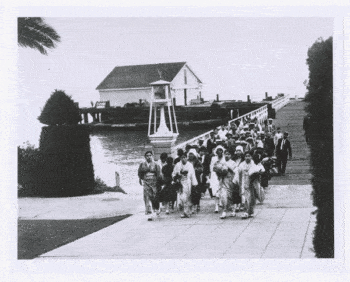
Written by Mia Mercer
Asian Americans and Pacific Islanders have played a key role in American history since the first Chinese immigrants arrived in the U.S. in the 1850s following the California Gold Rush. That’s why May is recognized as Asian American and Pacific Islander (AAPI) Heritage Month.
Vanita Reddy, a professor in the Department of English at Texas A&M University, researches the intersections of race, sexuality and gender in global contexts. This interview explores the importance of this month and provides suggestions to become more aware of AAPI.
What are the origins of AAPI Heritage Month?
AAPI month originated with Congress in 1978. Then-president Jimmy Carter started a week-long celebration in the first week of May, and over the next decade, presidents passed annual proclamations sort of renewing the idea that we need to celebrate Asian Americans and Pacific Islanders for this week-long period.
Then in 1990, Congress passed a law that expanded the observance of this week into a month-long event, and in 1992 Congress passed a law that designated the whole month of May as AAPI Heritage Month.
Chinese and Japanese immigrants kind of became the reason for AAPI month, and I would say they’re often over-represented in Asian American studies. When we think about who is an Asian American, our minds might go to Chinese and Japanese Americans first, and that’s very tied to this history of the law.
The month of May was chosen to commemorate the first immigration of the Japanese to the U.S. on May 7, 1843, and also to mark the completion of the transcontinental railroad on May 10, 1869. So the May dates are significant for celebrating AAPI Heritage Month. The Chinese immigrants were critical to the infrastructure of the U.S.

Immigrants arriving at Angel Island, 1931. National Archives and Records Administration
Why is it important to recognize AAPI Heritage Month?
One thing we should be critical of as scholars and activists is the fact that AAPI Heritage Month is a state-endorsed month. This month is an act of Congress that’s meant to commemorate. On one hand, we might take pride in the fact that the U.S. state wants to recognize us as a racial group; on the other hand, we need to be skeptical of any kind of state-endorsed project like this and consider what the underlying motives for these projects might be.
Like other celebrations of cultural contributions by different racialized groups, AAPI Heritage Month is often difficult to separate from multiculturalism and from our desire to be more multicultural. Most of us are taught that to be multicultural is a good thing, something we should aspire to. So we need to understand what multiculturalism is and what’s wrong with multiculturalism.
What is multiculturalism, and how does it affect AAPI Heritage Month?
I would define multiculturalism as recognizing, celebrating, and maintaining difference as a response to the state-sanctioned separation of races and the violence of racial management.
Multiculturalism does three things: One, it is the politics of recognition which is saying, “We see you as a non-white racial other.” The second thing it does is celebrate differences, which is saying, “We celebrate your traditions as a non-white racial other.” Third, multiculturalism tolerates this difference, saying, “I tolerate you because of those traditions and the way that they add value to making our society more diverse.” So recognizing, celebrating difference, and tolerating difference are the three things that multiculturalism does.
Multiculturalism tried to address the problem of racial separation and racial violence by becoming a state-sanctioned institutionalized practice, specifically at the university level. In the 1960s and 70s, there were a lot of student-led protests that were called the “Pan Ethnic Third World Strikes.” This happened at San Francisco State University (SFSU), which was part of the larger national civil rights struggle. These strikes at SFSU were fighting against a generally accepted practice of monoculturalism, and students and professors said they don’t want to just learn about white culture as what counts as American history. Multiculturalism was the response to the monocultural project.
Not only was multiculturalism accepted, but we are now in a moment where it becomes endorsed by the state through things like Black History Month and now AAPI Heritage Month. This is also why we have the creation of women’s studies and ethnic studies departments in universities, which were responses to the strikes at SFSU in the 1960s. This is all-important because AAPI Heritage Month comes out of this law that’s passed in 1978 by then-president Jimmy Carter.
Multiculturalism can also function to manage racial differences, but not address racism. If we celebrate AAPI Heritage Month by recognizing the violence of the Chinese Exclusion Act (the first race-based exclusion law passed in the U.S.), then we would have a positive contribution toward AAPI Heritage Month. But often this heritage month becomes a way to celebrate cultural differences without addressing racial violence. Even the term multiculturalism can function to turn racial difference into cultural difference so that we don’t have to talk about race or racial violence. As with Black History Month in February, AAPI Heritage Month often looks like celebrating Asian and Asian American cultural differences rather than fighting for Asian American racial justice, and that can often blind us from ongoing racial injustice.
AAPI Heritage Month uses the word “heritage” instead of “history.” How does that affect the celebration of this month, if at all?
I’m really struck by how this month is called “AAPI Heritage Month” and not “AAPI History Month,” because it cements this idea that Asian Americans have this heritage but not a history in this country — which is problematic.
It overlooks the very real way that Asian immigrants are integral to American history. Since February is called Black History Month, why isn’t this also called AAPI History Month? There are a lot of historical contributions that Asian immigrants have made to the U.S. that really need to be recognized by everyone.
The term “heritage” is particularly problematic for Asians precisely because of the way that Asian immigrants have been rendered a perpetual foreigner in the U.S. That just reproduces this whole idea that Asians aren’t really Americans, because they only lay claim to a heritage rather than making everyone see how AAPI history is something we all should be concerned about.
We should not only celebrate Asian American and Pacific Islander heritage, but we should also want to transform the questions of heritage into one of history. That way, we are all answerable to these histories and heritages, and actually engaging with these histories in ways that hold us all accountable.

American Heritage Awareness Month Proclamation, May 3, 1993. National Archives and Records Administration.
Why is it important to recognize the differences between cultures and ethnicities?
The multiculturalism that emerged from the civil rights movement was never the goal of civil rights. The goal of civil rights was to have anti-racist politics, not multicultural politics. It wasn’t meant to appreciate difference; it was meant to combat racial injustice. So state-endorsed multiculturalism became one of the unexpected consequences of civil rights. One thing that came out of that is identity politics, which a lot of ethnic groups become really invested in.
So we not only have the separation of different racial groups, like African American, Latinx, and Asian American, but we also have this separation of different ethnic groups within those racial categories. Within the racial category, “Asian American” is ethnic groups like Vietnamese Americans, Chinese Americans, South Asian Americans, and Pacific Islanders. Asian American is a racial category that becomes a strategic coalition in the sense that it allows these different ethnic groups to gain rights and recognition from the state by laying claim to this racial identity.
But we also can’t forget that Asian American is a state-produced racial category. Government documents like the census force us to check that box even if we don’t think of ourselves as Asian Americans. For example, a lot of Arab Americans often don’t think of themselves as Asian American. AAPI as a category is a fragile, even if politically useful, political coalition. All Asians have very different relationships to the U.S.; that’s one of the reasons it is important to recognize the difference.
And then we have the Pacific Islander designation which is a really contentious designation within Asian American studies because of the way that Pacific Islanders actually often have more in common with indigenous populations than they do with Asian American ones. Specifically in Hawaii, a lot of people who identify as Pacific Islanders are often at the bottom rung economically and socially compared to their wealthier Chinese and Japanese counterparts who control most of the Hawaiian economy and have had more access to resources and wealth. There are these interethnic tensions in places like Hawaii which have a strong Pacific Islander population who would rather be understood as native or indigenous and not as Asian American.
So for all of these reasons, it’s important to recognize the difference between the ethnic groups of Asian American not only for the different historical relationships that these groups have to the U.S. but also for the kind of class and other stratifications that happen within the category and the different migration histories.
How can individuals recognize this month respectfully?
If we could transform the recognition of AAPI Heritage Month into a recognition of Asian American and Pacific Islander history, then we could maybe do some of this important work of recognizing Asian violence and Asian immigrant labor as contributions, not just cultural contributions that we can turn into a spectacle to be safely consumed or into commodity practices like yoga.
It’s great to recognize and celebrate yoga as a contribution of South Asian culture in the U.S. and I think it’s fine to do those things as long as we are also advocating for immigration reform and fighting against Islamophobia. Months like AAPI Heritage Month should ask more of us than they often do in terms of addressing racism and violence.
Photo







